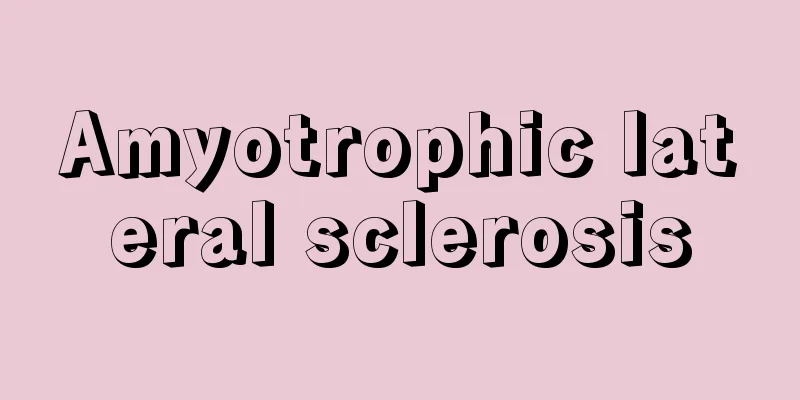Amyotrophic lateral sclerosis

|
(1) Amyotrophic lateral sclerosis (ALS) Definition/Concept Amyotrophic lateral sclerosis is a neurodegenerative disease in which both upper and lower motor neurons are almost selectively damaged, causing progressive generalized muscle atrophy and weakness. It mainly develops after middle age, and after an average of about three years, patients die or require permanent artificial ventilation. Approximately 90% of cases are sporadic, and some patients have a family history of the disease. Cause and Etiology The definitive cause of sporadic ALS is currently unknown. Possible causes include glutamate-induced excitotoxicity, mitochondrial abnormalities, axonal transport disorders, oxidative stress, cytoskeletal abnormalities, and neurotrophic factor abnormalities. 5-10% of cases have a family history, and causative genes such as SOD1, FUS, TDP-43, C9ORF72, optineurin, and UBQLN2 have been identified. Epidemiology The prevalence of ALS is reported to be 1.6-8.5 cases per 100,000 population, and the incidence rate is 0.6-2.6 cases per 100,000 population per year, and is thought to be roughly constant around the world. However, there are areas with high incidence rates, such as Guam and the southern part of the Kii Peninsula in Japan. The male to female ratio is approximately 3:2, with more men. The disease can occur in all adult age groups, but it is rare in people under the age of 40, and is most common in people in their 60s and 70s, with the peak incidence occurring in the late 60s. Pathological findings include degeneration and loss of Betz cells and large pyramidal cells in layer 5 of the motor cortex in the cerebral cortex, degeneration and loss of brainstem motor nerve nuclei other than those controlling the eye muscles in the brainstem, and fiber loss (Fig. 15-6-33) and gliosis in the pyramidal tracts of the lateral and anterior columns in the spinal cord, flattening of the anterior horns, and degeneration and loss of large anterior horn cells. Various forms of ubiquitin-positive inclusions, such as Bunina bodies (Fig. 15-6-34), which are eosinophilic inclusions within the cytoplasm, and skein-like inclusions, are found in the remaining anterior horn cells, which are characteristic of ALS. Immunohistochemical staining with anti-TDP-43 antibodies is characterized by the absence of staining that is usually seen in the nucleus, and staining of inclusions in the cytoplasm (Fig. 15-6-35). In some cases of frontotemporal lobar degeneration, characteristic TDP-43-positive inclusions are found widely throughout the cerebrum, and other commonly associated molecules such as FUS have also been found, suggesting that ALS and frontotemporal lobar degeneration may share some pathology. Clinical symptoms and findings : Symptoms and findings of progressive upper motor neuron degeneration include increased tendon reflexes throughout the body, spasticity, Babinski sign, Chaddock reflex, and forced crying and laughing. Symptoms and findings of lower motor neuron degeneration include muscle atrophy of the limbs and trunk, muscle weakness, bulbar symptoms such as dysarthria and dysphagia, tongue atrophy, respiratory muscle weakness, and fasciculation of skeletal muscles throughout the body (Figure 15-6-36). When lower motor neuron symptoms are relatively strong, spasticity is not noticeable, and tendon reflexes are rather reduced. As muscle atrophy throughout the body progresses, weight loss becomes noticeable. Depending on the initial symptoms and main symptoms, the disease may be classified into bulbar paralysis, upper limb type (common type), lower limb type (pseudopolyneuropathy type), etc. There are also cases where respiratory muscle paralysis is seen as the initial symptom, and cases where the disease begins with a dropped head symptom. The proportion of bulbar paralysis is higher in elderly patients who develop the disease. Ocular motility disorders, sensory disorders, and bladder/rectum disorders are not usually seen in ALS, and so these are important in the diagnosis. Pressure ulcers are also unlikely to develop, and together these are sometimes considered to be the four major negative symptoms. However, it has been observed that these symptoms are not rare in cases with a long history of disease, such as those on artificial ventilators. Cognitive impairment was previously not considered to be present, but it has been found that some cases are accompanied by frontotemporal lobar degeneration. Cognitive decline can precede muscle weakness or become apparent later. Test results: Needle electromyography reveals signs of chronic and progressive denervation, such as high amplitude potentials, polyphasic potentials, fasciculation potentials, and positive sharp waves. These reflect lower motor neuron degeneration and are important in diagnosis. Findings may be seen not only in atrophied muscles, but also in muscles where atrophy is not evident. Cerebrospinal fluid tests are often normal, although protein may be elevated. Serum creatine kinase (CK) is elevated in some cases. Prolongation of central motor nerve conduction time (CMCT) measured using motor evoked potentials (MEPs) using a magnetic stimulator may be observed. Diagnosis and Differential Diagnosis A thorough medical history and physical examination are required to confirm upper motor neuron and lower motor neuron symptoms, that symptoms are progressive, and to rule out other diseases. Needle electromyography findings are particularly important as test findings. Diseases that must be differentiated from ALS include cervical spondylosis, ossification of the posterior longitudinal ligament, multifocal motor neuropathy (MMN), monoclonal gammopathy, motor neuron disorders associated with malignant tumors such as lymphoma, polymyositis, inclusion body myositis, hexosaminidase deficiency, spinal and bulbar muscular atrophy, hyperthyroidism, tumors of the brain stem or spinal cord, syringomyelia, juvenile unilateral muscular atrophy of the upper limbs (Hirayama disease), post-polio syndrome, and diabetic amyotrophy. Symptoms are always progressive , and if artificial ventilation is not performed, the average period from onset to death is about 3 to 4 years. The most common causes of death are ventilatory failure due to weakened respiratory muscles and aspiration pneumonia. The rate and pattern of progression vary considerably from patient to patient. Long-term survival may be possible with the placement of an artificial ventilator. After being placed on a ventilator, some patients reach a totally locked-in state as ALS progresses, with the entire body, including eye movement, becoming immobile, while others are able to communicate using computer devices and remain involved in society. The only approved treatment is the glutamate antagonist riluzole, which has been shown to extend the survival time of ALS patients by approximately three months. Nutritional disorders caused by swallowing disorders are addressed proactively through swallowing training, instruction, and tube feeding via a gastrostomy. As bulbar palsy and upper limb dysfunction progress, it becomes difficult for patients to express their wishes, so communication support devices using computers, letter boards, etc. are introduced. For respiratory muscle paralysis, non-invasive positive pressure ventilation (NPPV), tracheotomy, and artificial respirator installation should be considered. However, sufficient informed consent is important when performing invasive procedures, and many patients choose not to undergo tracheotomy in particular. [Gen Sobue] ■ References Andersen PM, Abrahams S, et al: EFNS guidelines on the Clinical Management of Amyotrophic Lateral Sclerosis (MALS)-revised report of an EFNS task force. Eur J Neurol, 19: 360-375, 2012. Japanese Society of Neurology Ad Hoc Committee on Treatment Guidelines: ALS Treatment Guidelines 2002. Clinical Neurology, 42: 669-719, 2002. Source : Internal Medicine, 10th Edition About Internal Medicine, 10th Edition Information |
|
(1)筋萎縮性側索硬化症(amyotrophic lateral sclerosis:ALS) 定義・概念 筋萎縮性側索硬化症は,上位運動ニューロンおよび下位運動ニューロンの両者がほぼ選択的に障害され,全身の筋萎縮,筋力低下を進行性にきたす神経変性疾患である.おもに中年以降に発症し,平均3年ほどの経過で死亡もしくは永続的な人工換気導入に至る.約90%以上が孤発性で,一部の患者は家族歴を有する. 原因・病因 孤発性ALSについて,現在のところ確定的な病因は判明していない.想定される病因としてグルタミン酸による興奮毒性,ミトコンドリア異常,軸索輸送障害,酸化ストレス,細胞骨格異常,神経栄養因子異常などがあげられている.5~10%で家族歴があり,SOD1,FUS,TDP-43,C9ORF72,optineurin,UBQLN2などの原因遺伝子が同定されている. 疫学 ALSの有病率は人口10万人あたり1.6~8.5人,発生率は人口10万人あたり0.6~2.6人/年と報告されており,世界各地でほぼ一定であると考えられている.ただしグアム島,日本の紀伊半島南部などに発症率の高い地域がある.男女比は約3:2で男性が多い.発症は成人の全年齢層で可能性があるが,40歳未満はまれであり60歳代から70歳代が最も多く,60歳代後半に発症のピークがある. 病理 大脳皮質では運動野第5層のBetz細胞および大型錐体細胞の変性脱落,脳幹では眼筋支配以外の脳幹運動神経核の変性脱落,脊髄では側索と前索の錐体路に線維脱落(図15-6-33)とグリオーシス,前角の扁平化と大型前角細胞の変性・脱落を認める.残存する前角細胞に,胞体内のエオジン好性封入体であるBunina小体(図15-6-34)やskein-like inclusionなど種々の形態のユビキチン陽性封入体を認め,ALSに特徴的である.抗TDP-43抗体での免疫組織染色では,通常,核に認められる染色が認められず,細胞質の封入体が染まることが特徴(図15-6-35)である.前頭側頭葉変性症の一部でも大脳に幅広く特徴的なTDP-43陽性封入体を認め,ほかにもFUSなど,共通に関連する分子が見いだされていることから,ALSと前頭側頭葉変性症の一部は病態を共有している可能性が指摘されている. 臨床症状・所見 進行性の上位運動ニューロン変性による症状・所見として,全身の腱反射亢進,痙縮,Babinski徴候,Chaddock反射,強制泣き・笑いなどを認める.下位運動ニューロン変性の症状・所見として,四肢・体幹の筋萎縮,筋力低下,構音障害・嚥下障害などの球症状,舌萎縮,呼吸筋力低下,全身の骨格筋の線維束性収縮(fasciculation)をきたす(図15-6-36).下位運動ニューロン症候が相対的に強い場合には痙縮は目立たず,腱反射はむしろ低下する.全身の筋萎縮の進行に伴い,体重減少が目立つ.初発症状,主症状によって球麻痺型,上肢型(普通型),下肢型(偽多発神経炎型)などに病型分類されることがある.その他呼吸筋麻痺が初発症状としてみられる例や首下がり症状で発症する例がある.高齢発症例では球麻痺型の割合が高くなる. 眼球運動障害,感覚障害,膀胱直腸障害はALSでは通常認めないため,診断において重要である.また褥瘡は生じにくく,合わせて4大陰性症状とされることがある.しかし人工呼吸器を装着した例など長期経過例において,これらがまれならず認められることが経験されるようになった.従来,認知機能障害は認めないとされてきたが,前頭側頭葉変性症の合併が一部にあることがわかってきた.認知機能低下は筋力低下に先行する場合と,後から顕在化する場合がある. 検査成績 針筋電図では高振幅電位(high amplitude potential),多相性電位(polyphasic potential),線維束性収縮電位(fasciculation potential),陽性鋭波(positive sharp wave)など慢性および進行性脱神経所見を認める.これらは下位運動ニューロン変性を反映し,診断において重要である.所見は萎縮筋のみならず,萎縮の明確でない筋でも認められることがある.髄液検査は多くの場合正常であるが,蛋白は上昇することがある.血清クレアチンキナーゼ(CK)は一部の例で上昇がみられる.磁気刺激装置による運動誘発電位(MEP)を用いて測定した中枢運動神経伝導時間(CMCT)の延長を認める場合がある. 診断・鑑別診断 診断には十分な病歴聴取と診察により,上位運動ニューロン症候および下位運動ニューロン症候を認め,症状が進行性であり,他疾患の除外ができることが必要である.検査所見としては針筋電図所見が特に重要である.ALSと鑑別を要する疾患は,頸椎症,後縦靱帯骨化症,多発限局性運動性末梢神経炎(multifocal motor neuropathy:MMN),単クローン性高ガンマグロブリン血症(monoclonal gammopathy),リンパ腫など悪性腫瘍に伴う運動ニューロン障害,多発性筋炎,封入体筋炎,ヘキソサミニダーゼ欠損症,球脊髄性筋萎縮症,甲状腺機能亢進症,脳幹・脊髄などの腫瘍,脊髄空洞症,若年性一側上肢筋萎縮症(平山病),ポストポリオ症候群,糖尿病性筋萎縮症などがあげられる. 経過・予後 症状は常に進行性であり,人工換気を行わない場合,発症から死亡までの期間は平均3~4年程度である.死因は呼吸筋力低下による換気不全や嚥下性肺炎が多い.進行速度,進展様式は患者ごとのばらつきがかなりある.人工呼吸器装着により,長期生存が可能となる場合がある.呼吸器装着後にALSの進行により,眼球運動を含め全身が動かなくなる状態(totally locked-in state)になる例もある一方で,コンピューター機器などを用いたコミュニケーションを維持し,社会とのかかわりを保ち続ける患者もいる. 治療 治療薬としては唯一グルタミン酸拮抗薬であるリルゾールが承認されており,3カ月程度ALS患者の生存期間を延長する効果が認められている.嚥下障害による栄養障害に対しては,嚥下訓練,指導,胃瘻などによる経管栄養などの方法で積極的な対応を行う.球麻痺,上肢機能障害の進行により意思表出困難となるので,コンピューター,文字盤などを用いたコミュニケーション支援機器の導入を行う.呼吸筋麻痺症状に対して非侵襲的陽圧換気(non-invasive positive pressure ventilation:NPPV),気管切開,人工呼吸器装着の導入を考慮する.ただし,侵襲的な処置を行うにあたっては十分なインフォームドコンセントが重要であり,特に気管切開は実施の選択をしない患者も多く存在する.[祖父江 元] ■文献 Andersen PM, Abrahams S, et al: EFNS guidelines on the Clinical Management of Amyotrophic Lateral Sclerosis (MALS)-revised report of an EFNS task force. Eur J Neurol, 19: 360-375, 2012. 日本神経学会治療ガイドラインAd Hoc委員会:ALS治療ガイドライン2002.臨床神経学,42: 669-719, 2002. 出典 内科学 第10版内科学 第10版について 情報 |
Recommend
Chinese herbal medicine - Kanpouyaku
A general term for drugs used in Kampo (Chinese m...
Myotis ozensis (English spelling) Myotisozensis
…[Yoshiyuki Mizuko]. . . *Some of the terminology...
Tatsuta River
A river that flows through northwestern Nara Pref...
Azetentsuki - Azetentsuki
→Tentsuki Source : Heibonsha Encyclopedia About My...
Salt water pickling method
...Smoked products are made in the following orde...
Howells, William Dean
Born March 1, 1837 in Martins Ferry, Ohio [Died] M...
Yellow Press - Yellow Press
…Pulitzer, in opposition to the newspaper, hired ...
Watashima - Watashima Island
A place name found in articles related to the anci...
Maistre, Joseph de
Born: 1 April 1753 in Chambéry Died: February 26, ...
Bluebella (Chinese bell) - Bluebella
...The name "Kyusen" was given to this ...
Marine alga (English spelling)
…seaweed is a type of marine plant that is non-pl...
Halide Edip
1884‐1964 A Turkish female writer. Born in Istanbu...
Trigonia
Representative genus of the Trigonia family of th...
Annual meadow grass
An annual or biennial grass of the grass family (...
Yafu - Yafu
〘 noun 〙 (also "yabu") A man who lives i...

![Maximilian [I] - Maximilian](/upload/images/67cce398c538f.webp)







